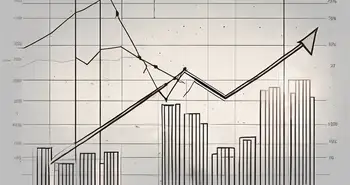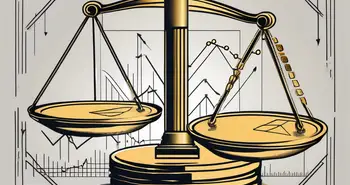What is Correction Territory in the Stock Market? Spotting Stock Market Corrections

As an experienced stock market analyst, I am often asked about the concept of “correction territory” in the stock market. In this article, I will explain the basics of stock market corrections, including their definition, the difference between corrections and crashes, and how to spot their indicators. We will also explore the impact of market corrections on investors and discuss strategies for navigating them. Additionally, we will delve into the role of media and sentiment in market corrections. By the end of this article, you will have a clearer understanding of correction territory and be better equipped to spot potential stock market corrections.
Understanding the Basics of Stock Market Corrections
Definition of Stock Market Correction
Before we dive into the details, let's establish what exactly a stock market correction is. In the financial world, a correction occurs when the price of a particular index or security declines by 10% or more from its recent peak. It is a temporary reversal in an upward trend and is considered a healthy and normal part of market cycles. Corrections help to create a more balanced and sustainable market environment, preventing excessive speculation and potential bubbles.
During a correction, investors may experience increased volatility and uncertainty in the market as prices fluctuate. It is essential for investors to stay calm and focused on their long-term investment goals during these periods. Historically, stock market corrections have been followed by periods of recovery and continued growth, highlighting the cyclical nature of financial markets.
The Difference Between Corrections and Crashes
It is important to differentiate between corrections and crashes. While both involve significant market declines, their magnitudes and durations set them apart. A correction typically lasts for a shorter period, commonly a few weeks or months, and sees market prices decline by around 10%-20%. On the other hand, a crash is a severe and sudden market decline, often characterized by a drop of 20% or more. Crashes can have a more profound and prolonged impact on investor confidence and the overall economy.
Investors often view corrections as healthy opportunities to reassess their portfolios and potentially purchase stocks at lower prices. By contrast, market crashes can lead to panic selling and widespread fear among investors, causing further downward pressure on stock prices. Understanding the differences between corrections and crashes can help investors make informed decisions and navigate turbulent market conditions with greater confidence.
The Causes and Indicators of Market Corrections
Market corrections, a natural part of the stock market cycle, can be triggered by a multitude of economic factors. While changes in interest rates are a common cause, other influential factors include shifts in economic indicators signaling a slowdown in growth, escalating geopolitical tensions, or unforeseen events that have ripple effects on global markets. For example, the sudden outbreak of a global pandemic can swiftly lead to a market correction as investors grapple with uncertainty and adjust their investment strategies accordingly.
Moreover, the interconnected nature of today's financial markets means that developments in one region can have far-reaching consequences worldwide. A financial crisis in one country can trigger a domino effect, causing market corrections in other economies as well. Understanding these interdependencies is crucial for investors seeking to navigate the complexities of market corrections and protect their portfolios.
Economic Factors Influencing Corrections
Market corrections can be triggered by various economic factors. Among the common causes are changes in interest rates, economic indicators signaling a slowdown, geopolitical tensions, or unexpected events impacting global markets. For instance, when the Federal Reserve raises interest rates, it can lead to a correction as investors reassess their risk appetite and reposition their portfolios.
Technical Indicators of a Correction
Technical analysis plays a crucial role in identifying potential corrections. Chart patterns, such as a downward trendline break or a series of lower highs and lower lows, can provide early warning signals. Additionally, indicators such as the Relative Strength Index (RSI) or moving averages can help gauge market momentum and determine when the market may be due for a correction.
Expert Tip: As an experienced investor, I have found that combining fundamental analysis with technical indicators yields the best results. By considering the overall economic landscape and market sentiment in conjunction with technical signals, you can enhance your understanding of potential market corrections and make more informed investment decisions.
The Impact of Market Corrections on Investors
Short-Term vs Long-Term Effects
Market corrections can have both short-term and long-term effects on investors. In the short term, corrections can be emotionally challenging, especially for those who have recently entered the market or have heavily invested in stocks. Seeing portfolio values decline can instill fear and uncertainty in investors. However, it is essential to remember that corrections are part of the natural market cycle and represent buying opportunities for long-term investors.
Risk Management During Corrections
During market corrections, it is crucial to have a well-defined risk management strategy in place. This includes diversifying your portfolio across different asset classes, sectors, and geographies. By spreading your investments, you can reduce the impact of a correction on your overall portfolio. Additionally, having a predetermined exit plan or stop-loss orders can help limit losses and protect your capital.
Expert Advice: Drawing from my own experience, I highly recommend investing for the long term rather than trying to time the market. Attempting to predict the exact timing of market corrections is incredibly challenging, even for seasoned professionals. Instead, focus on strategies such as dollar-cost averaging, where you invest a fixed amount regularly, regardless of the market's ups and downs. This approach minimizes the impact of short-term market fluctuations and allows you to benefit from the long-term growth of the market.
Strategies for Navigating Market Corrections
Diversification and Asset Allocation
Diversification is a key strategy for navigating market corrections. By spreading your investments across different asset classes, industries, and regions, you can reduce your overall risk exposure. This means that if one sector or region experiences a correction, other areas of your portfolio may provide some stability. Additionally, regularly rebalancing your portfolio can ensure that your asset allocation aligns with your investment objectives.
Timing the Market: Is it Possible?
Timing the market, or attempting to buy at the lowest point and sell at the highest, is a virtually impossible task. Instead of guessing market movements, focus on long-term investing principles. Invest in strong, fundamentally sound companies with a track record of success. By focusing on the long-term potential of your investments, you can ride out market corrections and potentially see significant returns over time.
The Role of Media and Sentiment in Market Corrections
Media Influence on Investor Behavior
The media plays a significant role in amplifying market sentiment during corrections. News outlets often highlight the negative aspects of market downturns, sensationalizing the potential impact. This can lead to panic selling and unnecessary market volatility. As an investor, it is crucial to filter out the noise and maintain a disciplined approach. Focus on objective analysis rather than being swayed by sensational headlines.
Investor Sentiment and Market Psychology
Investor sentiment and market psychology can heavily influence market corrections. During periods of euphoria, when the market is reaching new highs, investors may become overly confident and disregard potential risks. Conversely, during corrections, fear and uncertainty can lead investors to sell off their holdings, exacerbating the decline. Understanding these behavioral patterns can help you navigate market fluctuations with a disciplined and rational approach.
Expert Story: Early in my investment career, I made the mistake of letting media headlines dictate my investment decisions during a market correction. The constant barrage of negative news led me to sell off some of my holdings, only to regret it when the market quickly bounced back. Since then, I have learned the importance of staying calm, sticking to a long-term plan, and ignoring the noise generated by the media during corrections.
FAQ – Frequently Asked Questions
What is correction territory in the stock market?
In the stock market, correction territory refers to a decline of 10% or more from the recent peak of a particular index or security. It is a temporary reversal within a broader upward trend.
How long do market corrections typically last?
Market corrections can vary in duration but typically last for a few weeks to several months. However, the timing and duration of corrections can be unpredictable.
Should I sell my stocks during a market correction?
Selling stocks during a correction can be a hasty decision driven by fear and panic. Instead, consider your long-term investment goals and strategy. Corrections often present buying opportunities for long-term investors.
Can I time the market and avoid corrections?
Timing the market and avoiding corrections is extremely difficult, even for seasoned professionals. It is generally recommended to focus on a long-term investment strategy and not try to predict short-term market movements.
How can I protect my portfolio during a market correction?
To protect your portfolio during a market correction, diversify your investments across different asset classes, sectors, and geographies. Additionally, regularly review and rebalance your portfolio to ensure it aligns with your investment objectives.
By staying informed, maintaining a disciplined approach, and understanding the nature of market corrections, you can navigate these temporary downturns with confidence. Remember, correction territory is a normal and necessary part of the stock market, and by spotting its indicators, you can seize the opportunities it presents for long-term investment success.
As you navigate the ebbs and flows of the stock market, consider the advanced trading capabilities Morpher offers to enhance your investment strategy. With Morpher.com, you can trade across a multitude of asset classes, including stocks, cryptocurrencies, and more, without the burden of fees or lack of liquidity. Embrace the power of fractional investing, short selling, and up to 10x leverage to capitalize on market corrections and expand your portfolio's potential. Ensure your investments are secure with the Morpher Wallet, and experience the innovation of blockchain-based trading. Ready to transform your trading experience? Sign Up and Get Your Free Sign Up Bonus today and join the future of investing with Morpher.

Disclaimer: All investments involve risk, and the past performance of a security, industry, sector, market, financial product, trading strategy, or individual’s trading does not guarantee future results or returns. Investors are fully responsible for any investment decisions they make. Such decisions should be based solely on an evaluation of their financial circumstances, investment objectives, risk tolerance, and liquidity needs. This post does not constitute investment advice.

Painless trading for everyone
Hundreds of markets all in one place - Apple, Bitcoin, Gold, Watches, NFTs, Sneakers and so much more.

Painless trading for everyone
Hundreds of markets all in one place - Apple, Bitcoin, Gold, Watches, NFTs, Sneakers and so much more.









